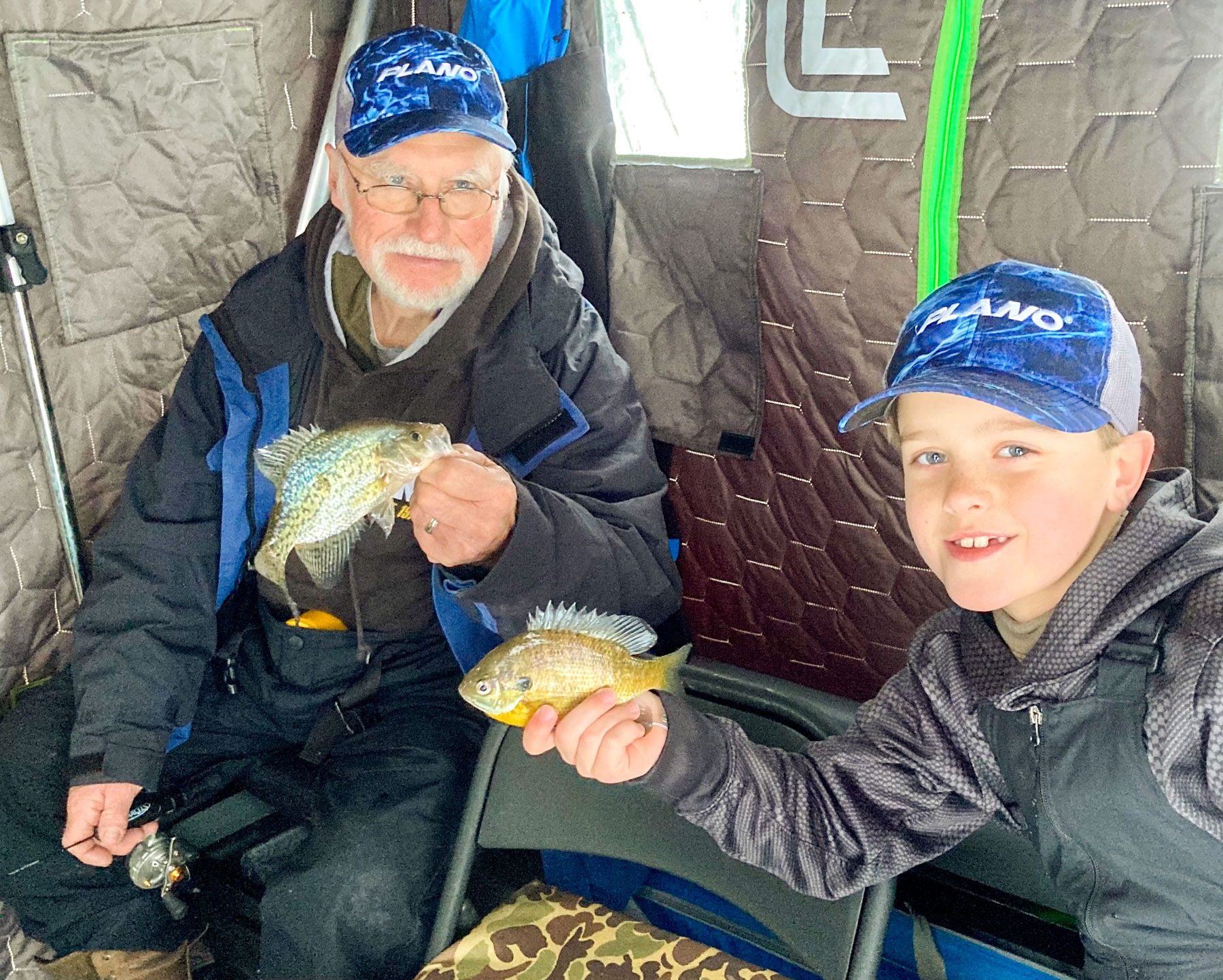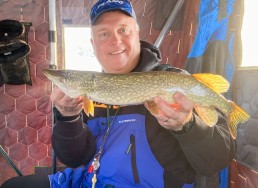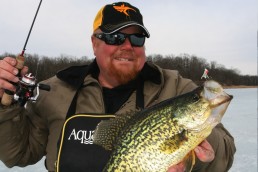Go Small, Light and Portable to Catch Slabs at Early Ice
SHARE THIS POST
“About another fifty yards,” I answered my fishing partner walking behind me. We were walking out onto an area lake with my Clam Fish Trap Voyageur XT Thermal Ice Team loaded with an auger, sonars, an underwater camera, and panfishing rods and tackle. It was mid-December. There was about 6 to 8 inches of ice on the lake, and I knew right where the sunnies and crappies would be biting.
We pulled up to the spot marked on my Humminbird Helix Ice 7 GPS, popped a hole with my Strikemaster Lithium Ion 40V, and lowered the underwater camera for a look-see. Several nice-sized sunfish were immediately visible, slowly patrolling the deep, soft bottom at the tip of a weedy shoreline point. We popped four more holes, secured the camera in the first hole, pointing at two of the new holes, and flipped over the top of the Fish Trap.
Crappie minnows suspended under a slip float went down the two holes furthest from our seats, and we started jigging small jigs tipped with Euro Larvae in the holes closest to us, with our Humminbirds lighting up with fish beneath us. We caught over a hundred sunfish in a few hours that afternoon—including dozens of very nice ones—with a few crappies mixed in.
So goes early-ice fishing action for panfish. Once the ice is safe enough to walk on, it is time to get out on the ice and catch some slabs.
While panfish can be caught all winter, first and last ice are the best times to catch numbers and size combined. If you wait until you can drive out on the lake with a wheelhouse, you can miss some of the best action of the ice fishing season.
Fish location can vary depending on the lake, how far along the ice is, how much the weeds have died off, and how far the water temperature has dropped. On some lakes, we are fishing the entrances to shallow, still-weedy bays for sunnies and crappies in December; on others, the pannies have already headed deeper towards their mid-winter haunts. Good places to look are the afore-mentioned entrances to shallow weedy bays; at the tips of shoreline points that had good weed cover in the summer; and deep, soft-bottomed holes near shallower weedy reefs or shoreline flats. It will take some looking, as there won’t be villages of wheelhouses set up on fish like they are later in the season. But once you find locations that have panfish, mark them on your GPS and record the in a logbook (or on your phone notebook) with the ice thickness and date. Patterns usually repeat themselves each year on the same lake, so you will now have a pretty good idea where to look each year under the same conditions.
Use a sonar or camera to search spots for fish. No fish? Move on. Don’t drill multiple holes and start fishing until you see some fish. If you stop seeing or catching fish, then move on and start looking for fish again.
As the season progresses and the ice thickens, keeper-sized panfish head towards deep soft-bottom basin areas, so they are moving. Just because you caught them in a spot last weekend, that doesn’t mean they will still be there this weekend. Once the fish set up in deeper spots under thicker ice, then finding them stops being the challenge. The new challenge during midwinter becomes being there when they decide to bite, and dealing with finicky bites due to weather changes, vehicle traffic and fishing pressure. Once you find early-ice pannies, they will usually bite, and often all day rather than just early and late in the day like later in the season.

Are you enjoying this post?
You can be among the first to get the latest info on where to go, what to use and how to use it!
Keep equipment simple to stay light, portable, and efficient. A portable flip-over type shelter like the Clam Fish Trap series is the way to go on cold or windy days. You can set it up and take it down quickly, and it is easy to pull from spot to spot. On warmer, calmer days, try pulling your equipment around in a sled and sitting outside on a stool. This is a great way to catch fish and enjoy the sights and sounds of a nice day outside.
An underwater camera can be helpful, especially for finding fish, but a good ice fishing sonar unit is all you really need. I use the Humminbird Helix Ice 7 and Ice 55. The 55 is strictly a flasher, and I think the brightest, quietest and easiest-to-read unit on the market. The Helix Ice 7 can be used as a flasher, LCD Graph and GPS with mapping chip capability all in one unit.
I bring two rods for each person. I have one for each person rigged with a larger, vertical jig to tip with a crappie minnow and suspend under a float or a dead stick. Each person then jigs with a horizontal jig, like a Custom Jigs and Spins Gill Pill or VMC Tungsten Tubby Jig tipped with a Euro Larvae, waxworm, or Berkley Gulp 1-inch Fish Fry. The Tungsten jig is especially useful when fishing deep water, as it is heavy but still small, so it can get back down to the fish quickly and still trigger strikes with its small size, even if the fish are finicky.
For vertical jigging small jigs, I use a 26- to 30-inch St. Croix Legend Black ice rod with a Fish 13 Decent Inline Ice Reel spooled with 2-pound-test fluorocarbon for stealth in cold clear water. The in-line operation of the inline ice reels eliminates line twist and spinning of your small jig once it is down to the fish. Anyone who has ever used an underwater camera has witnessed finicky panfish spooking from a small jig spinning in front of them due line twist. Give these reels a try—I think you will like them.

If you don’t have a camera down, (learn to) use your flasher to read how fish respond to your offering and can find the presentation that leads to bites. As aggressive as the often are at this time of year, the presentation, size and color of the bait may not matter. Carry pink, white, orange, and chartreuse jigs—that should cover your needs.
For deadsticking crappie minnows, I go with a little heavier rod with a small spinning reel spooled with 6-pound-test Fireline with a fluorocarbon leader. This rig is still light and stealthy enough to catch crappies, which is what it usually entices, and the heavier rod and line are enough to fight and land northerns and walleyes you catch from time-to-time.
Stay small, light and portable as soon as you can walk out on the ice, and you will be successful at catching early-ice panfish. That day in December, my fishing buddy and I moved my Fish Trap up shallower on the shoreline point as the sun began to set, and we proceeded to catch a few more sunfish and a bunch of nice crappies, as well as two northern pike more up in the weeds. Portability and versatility allowed us to stay on the bite and catch multiple species, and it will for you as well.
So don’t sit home and wait for the ice to thicken enough for you to drive on. Beat the rush, get out on the ice when it is safe to walk on, and cash in on some of the best ice fishing for panfish of the season.
MWO
SHARE THIS POST
Did you enjoy this post?
You can be among the first to get the latest info on where to go, what to use and how to use it!
Troy Smutka
Troy Smutka is a central Minnesota fishing guide (greatdayonthewater.com) and a walleye tournament angler. He is also a member of the Lund Boats, Mercury Outboards and Johnson Outdoors Pro Teams, and hosts and produces Fishing and Hunting the North Country on YouTube.



